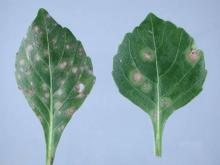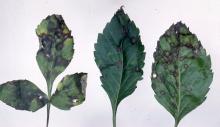Cause Entyloma dahliae (formerly Entyloma calendulae f. dahliae), a soilborne fungus. It overwinters in plant debris in soil. It is not transmitted in dahlia seed or tubers but could move via soil on tubers. High humidity and wetness favor disease development.
Symptoms Yellowish, circular to irregular spots appear on leaves, which later become brown and dry. Severe infections may result in reduced vigor or poor tuber development. Young cuttings or seedlings may die if infected early in the year.
Cultural control
- Remove and destroy plant debris.
- Space plants for good air circulation and drying conditions.
- Maintain proper fertility and soil pH between 6.0 and 6.2.
- Plant immune cultivars.
- Avoid overhead irrigation.
Chemical control No chemicals are specifically labeled, but broad-spectrum products such as copper or mancozeb-based materials used for flower blight control will help control smut.
Reference Mordue, J.E.M. 1984. Entyloma calendulae f. dahliae. CMI Descriptions of Pathogenic Fungi and Bacteria, No. 802. Surrey, England: Commonwealth Mycological Institute.


